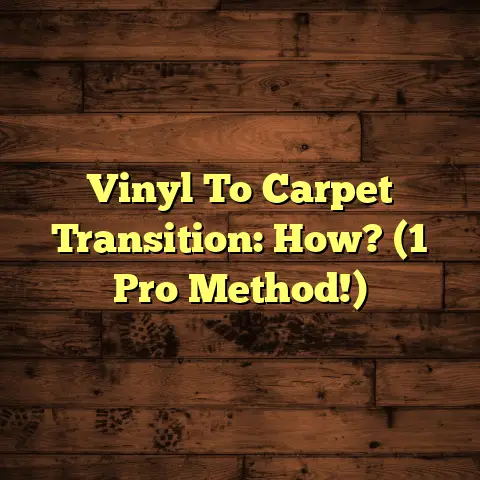Epoxy On Wood Floors? (7 Costly Mistakes!)
Have you ever noticed how much allergies are affecting modern homes? It’s a real issue!
And guess what? Your flooring might be contributing to the problem.
Think about it: Wooden floors can harbor all sorts of allergens like dust mites, mold, and pet dander.
Yuck!
I’ve seen a growing trend of homeowners trying to create healthier living spaces. And that’s awesome!
One solution that often comes up is epoxy.
But hold on a sec!
While epoxy can be a great option for wood floors, it’s not without its potential pitfalls. Trust me, I’ve seen it all!
That’s why I’m here to walk you through the 7 most costly mistakes I’ve witnessed when applying epoxy on wood floors.
Let’s dive in, shall we?
Section 1: Understanding Epoxy and Its Benefits
So, what exactly is epoxy?
In simple terms, it’s a thermosetting polymer that, when mixed with a hardener, creates a durable, hard, and chemical-resistant surface.
Think of it as liquid plastic that transforms into a super-tough coating.
As a flooring material, epoxy offers some serious benefits:
-
Durability: Epoxy can withstand heavy foot traffic, impacts, and even some chemicals.
-
Water Resistance: Say goodbye to water damage! Epoxy creates a seamless, non-porous surface that prevents water from seeping into your wood.
-
Aesthetic Appeal: Epoxy can be tinted, colored, or even embedded with decorative items to create a truly unique and stunning floor.
But here’s a big one for allergy sufferers:
Epoxy can significantly reduce allergens.
How? By sealing the wood and creating a non-porous surface, epoxy prevents dust mites, mold, and other allergens from finding a home in your floor.
It’s like creating a barrier against those pesky irritants.
Section 2: Mistake #1 – Not Properly Preparing the Wood Surface
Okay, folks, listen up!
This is HUGE!
Surface preparation is the foundation of any successful epoxy flooring project.
I cannot stress this enough.
Think of it like building a house: You wouldn’t start building on a shaky foundation, would you?
The same goes for epoxy.
Neglecting to properly prepare the wood surface can lead to poor adhesion and premature failure of the epoxy coating.
Trust me, I’ve seen it happen way too many times.
So, what does proper surface preparation entail?
-
Cleaning: Remove all dirt, dust, grease, and other contaminants from the wood surface.
I recommend using a degreaser and a good scrub brush.
-
Sanding: Sanding creates a textured surface that the epoxy can grip onto.
I typically start with a coarser grit sandpaper (80-grit) and gradually move to a finer grit (120-grit) for a smooth finish.
-
Repairing Damage: Fill any cracks, holes, or other imperfections with a wood filler.
Make sure the filler is completely dry before sanding.
I have seen people skipping sanding, thinking “it looks clean enough”, only to have the epoxy peel off within months.
It’s a costly mistake that can be easily avoided.
Section 3: Mistake #2 – Choosing the Wrong Type of Epoxy
Did you know there are different types of epoxy?
Yep!
And choosing the wrong one for your wood floor can be a recipe for disaster.
Let’s break down some of the most common types:
-
100% Solids Epoxy: This type of epoxy contains no solvents or water, resulting in a very durable and chemical-resistant coating.
It’s a great option for high-traffic areas, but it can be more difficult to work with due to its high viscosity.
-
Water-Based Epoxy: Water-based epoxy is easier to apply and has lower VOCs (volatile organic compounds) than solvent-based epoxy.
It’s a good choice for residential applications, but it may not be as durable as 100% solids epoxy.
-
Solvent-Based Epoxy: Solvent-based epoxy is known for its excellent adhesion and durability.
However, it contains high levels of VOCs and requires proper ventilation during application.
So, which type of epoxy is best for wood floors?
In my experience, 100% solids epoxy is often the best choice for wood floors that will see a lot of use. It offers the best combination of durability, water resistance, and chemical resistance.
However, it’s important to consider the specific requirements of your project and to consult with a flooring professional to determine the best option for your needs.
I once had a client who insisted on using a water-based epoxy because they were concerned about VOCs.
However, their floor was in a high-traffic area, and the water-based epoxy quickly wore down, resulting in a costly re-do.
Section 4: Mistake #3 – Ignoring Environmental Conditions
Epoxy is a bit of a diva when it comes to environmental conditions.
Temperature and humidity can significantly affect the curing process of epoxy.
If the temperature is too low, the epoxy may not cure properly, resulting in a soft, sticky finish.
If the humidity is too high, the epoxy may blush (develop a cloudy or hazy appearance).
According to the Epoxy Resin Committee (ERC), the optimal temperature range for epoxy application is between 65°F and 85°F (18°C and 29°C).
The relative humidity should be below 75%.
| Environmental Factor | Optimal Range | Potential Risks if Ignored |
|---|---|---|
| Temperature | 65°F – 85°F (18°C-29°C) | Improper curing, soft finish |
| Humidity | Below 75% | Blushing (cloudy appearance), poor adhesion |
| Ventilation | Adequate | Trapped solvents, health hazards, poor curing |
I always recommend using a thermometer and hygrometer to monitor the temperature and humidity in the room before, during, and after epoxy application.
If the temperature is too low, you can use a space heater to warm up the room. If the humidity is too high, you can use a dehumidifier to lower the humidity.
Ventilation is also crucial.
Make sure the room is well-ventilated to prevent the buildup of harmful vapors.
I remember one job where we were applying epoxy in a basement with poor ventilation.
The fumes were so strong that we had to stop working and open all the windows and doors.
It was a valuable lesson about the importance of proper ventilation.
Section 5: Mistake #4 – Skipping the Primer Coat
Think of primer as the glue that holds everything together.
It’s a crucial step in the epoxy flooring process that many homeowners overlook.
A primer coat enhances adhesion between the wood surface and the epoxy coating. It also helps to seal the wood and prevent air bubbles from forming in the epoxy.
Without a primer, the epoxy may not properly bond to the wood, leading to peeling, cracking, and other problems down the road.
I recommend using a primer specifically designed for epoxy flooring.
Apply a thin, even coat of primer to the prepared wood surface and allow it to dry completely before applying the epoxy.
I had a client who thought they could save money by skipping the primer coat.
Big mistake!
The epoxy started peeling within a few months, and they had to pay me to come back and re-do the entire floor.
Trust me, the cost of primer is nothing compared to the cost of repairing a poorly applied epoxy floor.
Section 6: Mistake #5 – Applying Epoxy Too Thickly
When it comes to epoxy, more is not always better.
Applying epoxy too thickly can lead to a host of problems, including bubbling, cracking, and extended curing times.
The correct thickness for epoxy application depends on the type of epoxy you’re using and the manufacturer’s recommendations.
However, as a general rule, I recommend applying epoxy in thin, even coats.
This allows the epoxy to properly cure and prevents air bubbles from getting trapped in the coating.
If you need to apply multiple coats, make sure to allow each coat to fully cure before applying the next.
I once saw someone apply a single, thick coat of epoxy to their wood floor, thinking it would save them time.
The epoxy took forever to cure, and it ended up cracking and bubbling.
It was a complete disaster!
Section 7: Mistake #6 – Failing to Follow Manufacturer Instructions
I know it sounds obvious, but you would be surprised how many people skip reading the manufacturer’s instructions before applying epoxy.
These instructions are there for a reason!
They provide detailed information on how to properly mix, apply, and cure the epoxy.
Failing to follow these instructions can lead to a variety of problems, including improper curing, poor adhesion, and even health hazards.
Always read the manufacturer’s instructions carefully before starting your epoxy flooring project.
Pay close attention to the recommended mixing ratios, application techniques, and curing times.
I had a client who didn’t bother reading the instructions and mixed the epoxy with the wrong amount of hardener.
The epoxy never fully cured, and their floor remained sticky and unusable.
They had to hire a professional to remove the uncured epoxy and start over from scratch.
Section 8: Mistake #7 – Neglecting Maintenance and Care
Epoxy-coated wood floors are durable, but they’re not indestructible.
They require regular maintenance and care to keep them looking their best.
One of the most common mistakes homeowners make is neglecting to clean their epoxy floors regularly.
Dirt, dust, and other debris can scratch and dull the surface of the epoxy over time.
I recommend sweeping or vacuuming your epoxy floors regularly and mopping them with a mild detergent and water.
Avoid using harsh chemicals or abrasive cleaners, as these can damage the epoxy coating.
Another common mistake is failing to protect epoxy floors from heavy objects or sharp edges.
Place mats or rugs under furniture to prevent scratches and dents.
I have seen people dragging heavy furniture across their epoxy floors, causing deep scratches and gouges.
It’s a heartbreaking sight!
Proper maintenance also includes regular inspections for any signs of damage, such as cracks, chips, or peeling.
Address any damage promptly to prevent it from spreading.
Conclusion
So, there you have it: The 7 most costly mistakes I’ve seen when applying epoxy on wood floors.
I hope this article has been helpful and informative.
Remember, epoxy can be a great option for wood floors, but it’s important to be informed and cautious.
Weigh the pros and cons carefully and consider consulting with a flooring professional before undertaking such a project.
Trust me, a little bit of planning and preparation can go a long way in ensuring a successful and long-lasting epoxy floor.
Happy flooring!





